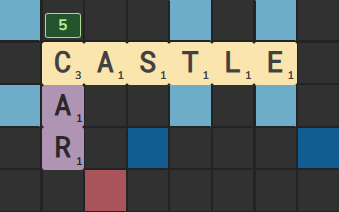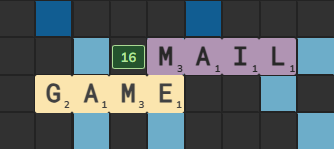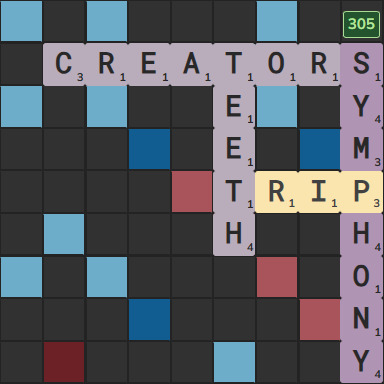This guide aims to address the various situations in which a player may be unsure of how many points a certain play will score them. It assumes that the reader already knows that:
- The base value of a word is equal to the total value of its tiles (blank/wild tiles are worth 0 points)
- Points are awarded for every new word formed by a play
- Letter multipliers are calculated before word multipliers
- The 50-point bonus for a bingo (all 7 tiles being used in one turn) is added after all other contributors to a word’s score have been calculated.
Additionally, it should be clarified that when you make a play, all of the letters you play must be placed in a single continuous straight line. If even a single letter you play is not part of the same line as the other letters, then the play is invalid.
Rule #1: Point multiplier squares only award points the first time that a tile is played on them.
Let’s say that Player 1 begins a match by playing the word “CASTLE” such that the “C” is on a double letter square. If Player 2 then plays a word that connects to the “C” in CASTLE, such as “CAR,” they will not benefit from the double letter square. The same principle applies to all letter and word multiplier squares on the board.

Rule #2: When a letter placed on a letter multiplier square forms two new words, it provides the multiplied value for both of those words.
Let’s say that Player 1 begins a match by playing the word “GAME” such that a double letter square is right above the “E.” Then Player 2 plays the word “MAIL” with the “M” on that double letter square. The value of the “M” will be doubled both for the word “MAIL” and for the word “ME,” resulting in an overall point value of 16 (7 points for “ME,” and 9 points for “MAIL”).

Rule #3: A word multiplier square can only apply to multiple words when all words pass through the multiplier square itself.
In the example below, the word “SYMPHONY” is played, forming the word “CREATORS” in the process. The triple word square under the final “Y” (in the lower right corner) only triples the value of the word “SYMPHONY.” The triple word square under the “S,” however, triples the values of both “CREATORS” and “SYMPHONY,” because both words pass through that square.

Rule #4: When a word is on two double word squares, its value is doubled and then doubled again (i.e., quadrupled). When a word is on two triple word squares, like in the example above, its value is tripled and then tripled again (which is the same as multiplying it by 9).
The value of 305 is arrived at by taking the value of the word “SYMPHONY” (which is 25; the “H” is on a double letter square), multiplying it by 3 to get 75, then by 3 again to get 225. This value is then added to the value of the word “CREATORS,” whose base value of 10 is multiplied by 3 due to the triple letter square under the “S” (making its total value 30). The combined value of both words is 255, and the 50 point bonus for playing a bingo brings the total to 305.